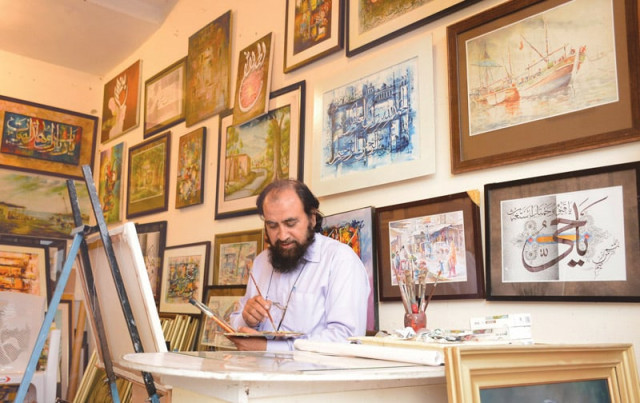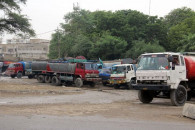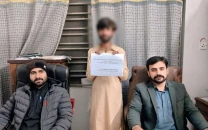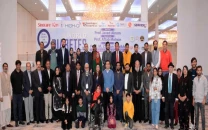Work of destiny: Artist carves his niche by merging calligraphy and architecture
Hanif Khan has been working in front of Lok Virsa Heritage Museum for over eight years

“I was fortunate enough to have parents who supported my craft and always encouraged me towards bettering myself at it,” said Khan, in an interview with The Express Tribune.

Furrowed in concentration, he sat behind his canvas, balancing a paint-smeared easle in one hand, at his compact gallery space which overlooks the Lok Virsa Heritage Museum, where he has been working for around eight years now.
Nature inspires Khan tremendously. Painting mainly with water colour and oil paint, he has merged distinct art genres of traditional calligraphy with the country’s architecture to create ‘constructive art’ which combines the spiritual with the synthetic in a visually-appealing manner.
This hybrid form of art features symmetrical views of heritage buildings across the country, intertwined with script of calligraphy, painted in bright and bold colours. Transparent, cubicle structures also figure in his work, as do portraits and scenes of old streets and markets of Rawalpindi.
“In my art practice, I’ve focused on innovating existing styles of art, which can serve a purpose. For this, I’ve highlighted the traditional architecture of the country from Multan to Sindh, which is unique and beautiful in its own way,” said Khan, who aims to promote a soft image of the country through his artwork.
His paintings are housed in various spaces across the country, including the National Defence University in Islamabad and Lyallpur Museum Faisalabad. He has also displayed his artworks in Iran, Oman, Saudi Arabia, the United States and U.A.E.

“I firmly believe that the nations who have a stronghold on architecture, calligraphy and language, progress and stand tall,” he added.
Khan has been trained under art exponents Mashkoor Raza, Mansur Rahi, Ghalib Baqar and the relatively obscure art teacher Sheikh Iqbal.
Commenting on the ambitious new generation of up-and-coming artists, Khan said they have a tendency to get influenced by and emulate the styles of well-known artists instead of carving their own niche. “The young artists have the advantage of technology. They can also study the canvases of famed artists more conveniently as compared to artists in yesteryears.”
However, Khan maintained that the principles of calligraphy were often ignored which affected the quality and composition of the recent artworks.
He also alluded to a general lack of awareness when it comes to recognising authentic art pieces of established artists. “I’ve observed that about 80 per cent people cannot tell an original from a fake painting and it is the responsibility of the artists to help the viewers discern their work, to curb such practice,” said Khan, adding that he has worked to dissuade people from buying copies of masterpieces in the local art market.
Citing the examples of world-famous Pakistani artists such as Sadequain Ahmed and Jamil Naqsh, Khan said emerging artists should focus more on refining their art rather than striving for networking opportunities at art galleries. “Your art should speak for itself.”
Khan graduated from the Karachi School of Art. He has served at Comsats Institute of Information Technology as a lecturer and imparts workshops on techniques of water colour painting in art schools.
Published in The Express Tribune, November 10th, 2014.



















COMMENTS
Comments are moderated and generally will be posted if they are on-topic and not abusive.
For more information, please see our Comments FAQ